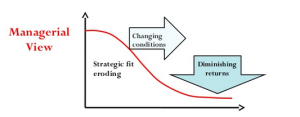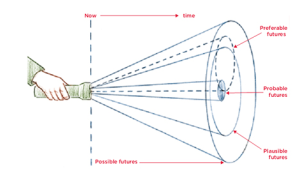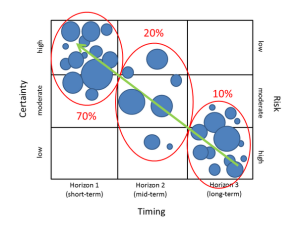The three horizons offer us much to frame our innovating future
 Following a couple of recent posts on reflecting on the three horizons methodology, firstly here and then here, I wanted to come back to where I see real value, in managing your innovating future.
Following a couple of recent posts on reflecting on the three horizons methodology, firstly here and then here, I wanted to come back to where I see real value, in managing your innovating future.
The 3H methodology enables us to look out into the future, across three different horizons that can manage the transition between the short, medium and long term in our innovation activities, something often badly lacking in most organizations’ thinking.
It allows us to gauge the challenges, adding aspects we are beginning to gain a sense of, transitioning from one position to another. It allows us to deepen our evaluation of the innovation portfolio of activities, resources and skillsets across different delivery frames of the short, medium and longer term.
It is one that requires us to reflect and possibly make a change, then we can move forward to meet the new challenges, within this emerging vision of the possible future.
So 3H is a way of working with change, it offers us a foresight and framing tool for drawing out our often conflicting discussions and views of what all this potential change might mean, from our established patterns or approaches and those that are possibly emerging. The 3H supports innovation management very well.
Accepting everything has a finite life-cycle
From my perspective we see businesses littered with not wanting to make a change, rejecting the changes going on all around them. These are happening in changing technology, different business models, and threats from competitors coming into the market with different and often low-cost models.

Sometimes a concept or product has ‘run its course’ is seen as yesterday’s solution, or industry segments separated in the past are suddenly ‘fused’ together in new ways due to new technologies, or being purposefully designed, they begin to disrupt the existing.
We can’t afford to ignore the ‘call of change’, it places our business at significant risk. Recognizing the challenges life-cycle management can bring, does need careful managing within our innovation management.
We do need to recognize changing conditions and begin to plan out our responses, both short and longer-term through a well-crafted transformation road map. The 3H can underpin this.
So where are you viewing the world from?
 Many of our organizations are viewing the world from where they are. This is often in the safety of their offices. They feel comfortable staying with what they know.
Many of our organizations are viewing the world from where they are. This is often in the safety of their offices. They feel comfortable staying with what they know.
They only see change when something suddenly triggers their perception and the world alters, and it then gives way to a new horizon of sight. Often these can come far too late.
What needs to challenge this place of “the world of where we are” and prompt fresh thinking so we can allow one of emerging knowledge and insight to enter into.
One where perhaps we are blending our imaginations, with some envisioned destination, where change will likely alter today’s dominant position. We need to prepare for it as these insights can radically alter our present position. We become open to change, to think differently.
We need to see the clues all around us
We need to reflect and see how we can forge those new innovation patterns. A methodology that helps raises our future consciousness and moves us to build new competencies for future competitive advantage is surely valuable?
We cannot stay trapped in our offices, our constant need is to find all possible means to be fully engaged and well-connected to the changes taking place within and across the world.
Managing the present, moving towards the future

In any future thinking, there are numerous uncertainties, yet we also need to address the familiar “the way we (presently) do things around here”.
We need to grapple with “how can we ‘keep the lights on” but equally move towards a different horizon without “betting the shop” and totally disrupting all we have built up? This requires even deeper thinking.
Something that requires us to re-equip, challenge existing and entrenched ways of working, bring in and fuse new skills and capabilities, push experimentation and exploration far more, tolerate failures in new ways, keep shareholders happy, recognise the need to make change for a potential sustaining future. Possibilities of changes in our ways of working and approach begin to unlock and open up to different thinking.
The unlocking of the future is partly recognizing the future patterns, yet is equally releasing us from the dominance of old ways of working, systems and structures – ways we have been increasingly sensing are no longer truly working well for us.
We need to shape our future intentions
 It is the second horizon; you can read a further post specifically on this 2nd horizon, “entering the zone of uncertainty” within this framework, which is the hardest one to work through.
It is the second horizon; you can read a further post specifically on this 2nd horizon, “entering the zone of uncertainty” within this framework, which is the hardest one to work through.
This is the transitory horizon, balancing today’s business with the investigations and new possibilities to lead towards a future.
Our abilities to manage this transitory zone (the 2h) is vital for our innovation management, it holds the key to staying locked in the present or moving towards a sustainable future built on different views and perspectives
For me the value of the 3H is in its use within innovation management.
 The three horizon framework offers a map of transformational potential which allows us to move towards finding new skills, degrees of new freedoms and creativity, we are striving for a balance between existing and preferred, based on present-day understanding.
The three horizon framework offers a map of transformational potential which allows us to move towards finding new skills, degrees of new freedoms and creativity, we are striving for a balance between existing and preferred, based on present-day understanding.
Scoping out the future needs for innovation to address needs different thinking. It needs foresight and exploration. It needs to allocate resources across the three different horizons and each of their respective challenges of the future needed from innovation.
This is why the 3H is, for me, a very valuable approach to managing innovation in the present and for the future.
The 3H framework prompts the need for transformational capacity.
I believe there is great value in exploring innovation possibilities through a framework that can support the often diverse management thinking, one that is far more strategic in its focus on exploring the options, working through different scenarios and mindsets, and then adjusting the resources accordingly, or identifying required new ones.
A framework that ‘sketches out’ that future promise can significantly improve strategic and innovation alignment, help set organizational direction and define and allocate resources appropriately.
It frames discussions, it is a navigational guide to allow for framing challenges and seeing perspectives in different frames so that they can be addressed. The 3H helps scope out the pathway of change from today’s existing innovation approaches.
It takes you through the key milestones to the future envisaged and allows you to distinguish different horizon challenges.
Working with the 3H approach can be a very powerful tool for managing our innovation future.
Any framework that draws out concerns, and differences of opinions and prompts transformational discussions, can be a very powerful management tool. If it provides the platform for framing and recognizing what needs to change.
If it can help to begin to flesh any capability gaps, stepping-stones to cross and if it can ‘point’ toward the action and activities that need to be put into place, so the organization can make their moves towards that different innovation future, then it has great value within any organization wanting to manage and structure its innovation activity.
I believe the three horizons approach can contribute significantly to this aim of managing innovation and giving organizations a sustainable future. I certainly recommend it.
10 thoughts on “Seeing Your Innovating Future Across Different Horizons”
Comments are closed.